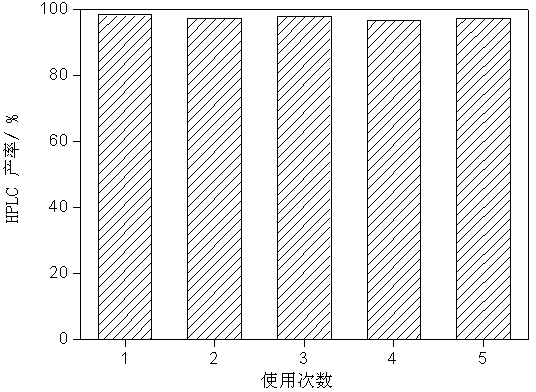Graphene oxide supported Schiff base palladium catalyst as well as preparation method and application thereof
A technology of Schiff base palladium and graphene, applied in the direction of physical/chemical process catalysts, organic chemical methods, chemical instruments and methods, etc., can solve the loss of palladium nanoparticles, reduce industrial applications, reduce catalytic activity and reusable performance, etc. problems, achieve good reusability, improve dispersion performance, and excellent reusability
- Summary
- Abstract
- Description
- Claims
- Application Information
AI Technical Summary
Problems solved by technology
Method used
Image
Examples
Embodiment 1
[0031] Cool 250 ml of concentrated sulfuric acid to about 0 °C, add 12 g of graphite powder and 8 g of sodium nitrate, slowly add 45 g of potassium permanganate under vigorous stirring, keep the temperature of the system not exceeding 20 °C, stir well and put Put it in a water bath at 35°C for 2 h, then add 800 ml of deionized water so that the temperature of the system does not exceed 98°C, and continue to stir for 20 min; add 700 ml of deionized water and 60 ml of 30% (w) H 2 o 2 , filtered while hot, with 1 mol·L -1 Wash the filter cake sufficiently with HCl until SO4 cannot be detected in the filtrate 2- , and then washed with deionized water to become neutral, and the sample obtained after centrifugation was freeze-dried to obtain black graphene oxide powder.
[0032] The preparation method of graphene oxide supported Schiff base palladium catalyst:
Embodiment 2
[0034] Put 0.2 parts of graphene oxide into 200 parts of nitrogen containing ethylenediamine, nitrogen dimethylformamide solution, the nitrogen of ethylenediamine, the mass fraction of nitrogen dimethylformamide is 5.0%, ultrasonic vibration 2 h, add 2.5 parts of dicyclohexyl carboximide and 2.5 parts of N-hydroxysuccinimide, and continue to sonicate for 1 h. Stir the reaction at a temperature of 80 °C for 12 h, cool to room temperature, and centrifuge the product, wash it with ethanol and distilled water in turn, and freeze-dry to obtain a black solid that is amidated graphene oxide; 0.2 parts of The amidated graphene oxide is added to 150 parts of ethanol solution containing 2-pyridineformaldehyde, the mass fraction of ethanol solution containing 2-pyridineformaldehyde is 5.0%, ultrasonic oscillation 2h, stirring reaction at reflux temperature for 12h, cooling to After the product is centrifuged at room temperature, it is washed with ethanol and distilled water in sequence, ...
Embodiment 3
[0036] Put 0.2 parts of graphene oxide into 200 parts of nitrogen containing ethylenediamine, nitrogen dimethylformamide solution, the nitrogen of ethylenediamine, the mass fraction of nitrogen dimethylformamide is 5.0%, ultrasonic vibration 2 h, add 2.5 parts of dicyclohexyl carboximide and 2.5 parts of N-hydroxysuccinimide, and continue to sonicate for 1 h. Stir the reaction at a temperature of 80 °C for 12 h, cool to room temperature, and centrifuge the product, wash it with ethanol and distilled water in turn, and freeze-dry to obtain a black solid that is amidated graphene oxide; 0.2 parts of The amidated graphene oxide was added to 150 parts of ethanol solution containing 2,6-diacetylpyridine, the mass fraction of the ethanol solution containing 2,6-diacetylpyridine was 5.0%, ultrasonic vibration was performed for 2h, and at reflux Stir and react at high temperature for 12 hours, after cooling to room temperature, the product is centrifuged, washed with ethanol and disti...
PUM
 Login to View More
Login to View More Abstract
Description
Claims
Application Information
 Login to View More
Login to View More - R&D
- Intellectual Property
- Life Sciences
- Materials
- Tech Scout
- Unparalleled Data Quality
- Higher Quality Content
- 60% Fewer Hallucinations
Browse by: Latest US Patents, China's latest patents, Technical Efficacy Thesaurus, Application Domain, Technology Topic, Popular Technical Reports.
© 2025 PatSnap. All rights reserved.Legal|Privacy policy|Modern Slavery Act Transparency Statement|Sitemap|About US| Contact US: help@patsnap.com

